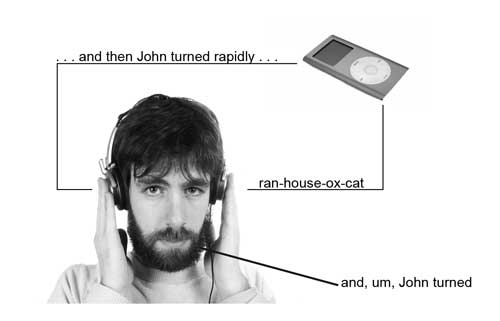Nine Dot Matrix
Connect the centers of all nine stars with four straight lines without lifting your instrument from the page.
Click here to see the answer.
This illusion was reprinted in the book by permission from Antonio Zamora.
When you look at the following picutre, simple stare at the center three dots. Concentrate on those dots for one minute. Stare only at the dots, and after that minute, turn and look at a blank wall. Just gaze at the wall for approximately 45 seconds. Allow yourself to look rather un-focused, but keep your gaze at the same space on the wall. Keep looking at the blank wall, even if you think nothing is going to happen. Something unique will happen, and you should know that this can be done with any number of pictures. What you will see will amaze you, even startle you.
The folowing illusion was chosen to demonstrate how emotions can be tangled with illusions. Everyone knows that a thirsty person in the desert can see a mirage (the illusion of an oasis or simply water) and lose rational abilities in favor of desperate emotions. The next illusion is an emotion-laden illusion. It will evoke a strong emotional response in accordance with a line of personal belief system. The illusion may please, it may inspire, it may anger—but the point of the illusion in this context becomes very clear: a simple illusion can evoke strong emotional reactions.
Once again, follow the instructions. Stare this time at the center four dots. Concentrate on those dots for one minute. Stare only at the dots, and after that minute, turn and look at a blank wall. Just gaze at the wall for approximately 45 seconds. Allow yourself to look rather un-focused, but keep your gaze at the same space on the wall. Keep looking at the blank wall, even if you think nothing is going to happen. Experience this illusion.
This is the rather famous witches and maiden illusion. At first glance, you will see either a witch or a beautiful young maiden. You are typically unable to see both at the same time—at least with conscious recognition per se. Shift the focus slightly, and the image changes. That is, if you see the witch first, shift focus and you will see the maiden.
Figure 7

Can you see both the face and the vase?
If you look closely, you will see a dalmatian with its nose down, sniffing the ground. You can make out the dog’s ear, snout, shoulder, and left leg first, and the rest fills itself in. Once you see the dog clearly, you cannot help but see it.
Our visual reference system often distorts images according to the background. The circle in the center is really a perfect circle.
There are no curved lines in the diagram.
There are only white circles between the black frames.
Figure 13
This is a classic example of context perception. You probably read, "The Cat." But look closely. What is the difference between the H in the word the and the A in the word cat? Remember, we often make up the context and/or decide on an approved context.
Figure 14

The lines are really equal in length.
Do you see the defect in the photo?
Click here to reveal the answer.
Although optical illusions are widely circulated on the Internet, most of the illusions used in this chapter were reprinted with permission from Antonio Zamora at scientificpsychic.com
The Amazing Brain
Consider some of the power
and tricks of the mind:
I cdnuolt blveiee taht I cluod aulaclty uesdnatnrd waht I was rdanieg The phaonmneal pweor of the hmuan mnid! Aoccdrnig to a rscheearch at Cmabrigde Uinervtisy, it deosn't mttaer inwaht oredr the ltteers in a wrod are, the olny iprmoatnt tihng is taht the frist and lsat ltteer be in the rghit pclae. The rset can be a taotl mses and you can sitll raed it wouthit a porbelm. Tihs is bcuseae the huamn mnid deos not raed ervey lteter by istlef, but the wrod as a wlohe. Amzanig huh? Yaeh, and I awlyas thought slpeling was ipmorantt.
Follow this link to see examples in other languages and learn more about the research behind this brain twister.
Book Color Pictures & Subliminal Embeds
WARNING: These pictures are for adults only
and are not appropriate for children.
The square marked A and the square marked B are actualy the same color.
Reprinted courtesy of Professor Edward H. Adelson, John and Dorothy Wilson Professor of Vision Science, Department of Brain and Cognitive Sciences, MIT. Website: http://persci.mit.edu/people/adelson
Watch this video for a demonstration of this illusion.
Figure 21

In a typical shadowing task, the messages are presented simultaneously to the left and right ears, and the subject attempts to shadow one ear.
Try saying the colors of each word out loud as you read left to right, top to bottom, as rapidly as possible. Remember, say the colors—you're not to read the words themselves.
As you can see, there is substantial interference between the spelling of the word and the color of the type. What should be a simple task becomes quite difficult.
When the brain is functioning in beta, perhaps under some stress at 30 cycles per second, the fencing material is very tightly woven (many lines per inch). When slowed down to 8 cycles per second, the fencing material is much more loosely woven (fewer lines per inch), and the result is simply a matter that more information can pass between the lines or gain entry to the other side of the fence.